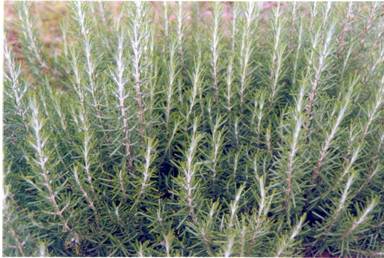Rosmarinus officinalis
Lamiaceae Economic part- Leaves and flowering tops
Major constituents- 1, 8-cineole(20-50%), borneol (20 %)
Uses- Cosmetics, perfumery, culinary purposes
Variety- Ooty-1
Rosemary-OOTY (RM)-1
 |
Ooty (R, M) Rosemary's Special Features :
- Ooty (R, M) 1 rosemary variety of horticultural research station maintained utakai was selected from five kinds of rosemary seedlings.
- The rapid growth of the plants of this variety (an average of 62 cm height) was not reached.
- The length of the leaves of this variety, roller, will be matankiyat inward.
- It gives the green leaf yield of 13 tons per year of this variety. The potential yield of 46 per cent is higher than the local irakattaik.
- The leaves are dark green, thick and is willing to skin. The green and dry leaves is ideal for cooking with good flavor.
- Harvested 215 days after planting seedlings in the first. The year can be harvested three times at intervals of 3 to 4 months.
|
|
- The variety of the leaf blight disease, the white fly and aphid resistant.
- This leaves a large number of content (0.9 per cent) higher levels of lactose content in the leaves (60.66 mg-kg) and protein (24.90 mikiki) found.
- In the mountainous areas of J% - J% Lie and September - October months of the rainfed crop can be planted.
- In mountainous areas (up to 900 m above sea level) to the optimal crop.
- The variety of the climate, such as drought and frost tolerant and grows.
Fed on organic farming (RM) 1 rosemary cultivation tips
Soil and climate
PH 5.5 to 7 varaikonta laterite soil with good drainage facilities suitable for rosemary. Soil pH of 2.5 tons per hectare when there is less than 5 ittup of talamaittai be planted in the soil. Frost-free tropical and subtropical summer monsoon (temperature less than 30 degrees), the temperature is optimal. At an altitude of 2500 meters above sea level, 900 of the first well in the kulirpirateca areas. |
 |
Season
Rosemary J.% of root seedlings - J% Lie and September - the months of October, suitable for rainfed crop planting.
Age
Perennial crop. Can be grown commercially until twelve years.
Land preparation
Panpatutta well be plowed land twice. 50 tons per hectare during the last plowing well-composted manure, neem cake a ton, 5-ton natural life force of compost manure is mixed with soil lead. 30 cm in height, 1.5 meters wide plots. Natumpolutu seedlings per acre and 5 kg 5 kg PSB supplying bio-fertilizers applied to the soil mix.
Seed size
50,000 seedlings - ha. |
 |
|

|
Seedlings from the breeding method
Before leaving for flowering plants to choose from 10 to 15 cm long pieces of cut. Leaves, leaving only the tip of the stem sticks to the bottom of the planting should be used to remove the remaining leaves. Before planting to enhance rooting of stem sticks herbal natural life force, fertilizer, bio-fertilizer solution containing 10 percent of the 20 minute walk back to thinking. Polythene bags filled with soil mix after the planting of the stem pieces and pour water twice daily to keep in shady areas. Sixty days, the rooted seedlings are ready for planting.
With the exception of the poly malaippaci budded seedling production
Planting
45 cm row to row and plant cetikkuc vittac root plants should be transplanted in 45 cm intervals. And 6 months after planting, the plant should be cut maiyattantai. By doing so, the plant grows well in the lateral branches. |
|
Water cannon
Drought tolerance is also suitable for planting in dry land. Green leaf with water in dry periods payccutalin get higher yield.
Practices
Basal FYM 50 t / ha, neem cake @ 1 t / ha, the natural life force Compost 5 t / ha and vermin-compost compost 5 t / ha can be applied as a seedling natumpolutu. Phosphobacterium bio-fertilizers, bio-fertilizers and inoculant and 5 kg per ha as basal dose required.
Application of bio-fertilizers
பாஸ்போபாக்டீரியம் and supplying fertilizers, such as from the second year after planting survival rate of 5 kg to 30 kg per hectare should be applied with FYM. The solution of 3 per cent per year, 5 times more pancakavyam telippatin the leaves will increase the quality and yield.
Post Treatment
A month later weeding nut boiling mud. 4 or 5 times per year need deadheading. The solution of 3 percent to 5 times a year Panchagavya foliar spray to spray at 10 days interval. Tacakavya 3 percent solution is to spray 3 times per year. Vermi compost 10 percent distilled water solution 3 times per year with a foliar spray to spray on a monthly interval. |

|
Crop Protection
It is resistant to pests and fungal diseases.
Yield
12 to 13 tons per hectare of green leaves
Harvesting
Rosemary plant leaves can be harvested at flowering stage. 30 to 35 cm in length with the flowering stage over the leaf stems should be harvested with sickles. Hard tanmaiyataiyata well developed trunk areas suitable for oil distillation. If you are using a number of filtering portions of the shaft with the number and complexity of the quality suffers and the mind. Yield in the first 215 days of the year preparing for planting. In the following years, three times per year, respectively, can yield three to four month intervals. |
|
|
Processing leaves
The leaves are harvested in the soil and removing the dust should wash three times. Then dried in the shade. Nilgiris dried up in the 10 to 15 days. Exactly equal to the plain areas, such as dried leaves, leaves scene to take concrete floor ventilation caused by the electric fan to keep dry. In the three days, with 10 percent moisture can get good quality leaves. Then the quality of the food to be stored in a Polyethylene bags.
Yield
2.5 tonnes per ha per year of dried leaves
|
 |
|
 |
Rosemary oil filtration
After harvesting the stem and leaves of rosemary oil obtained by steam distillation. Number of leaves can be dried in the shade of the same size. Subjecting to 120 minutes of continuous steam distillation and the number of doses can be high.
Oil yield
80 to 100 kg per ha
Cost: Rs 65,000 / -
Income per acre Rs 1,25,000 / - lakh
|
|
Rosemary herb's medicinal benefits:
1. helps prevent cancer disease
2 ittavarat aromatic oil extracted from the high-profile, perfumes, facial and bath soaps can be used as decorative items.
For various health problems, including indigestion, stomachache 3 ittavarat the leaf medicine and aromatic herb used in obstetrics.
4 rosemary oil to calm the mind, used to reduce blood pressure.
5. tea made with the leaves of rosemary improves resistance to infection following ingestion.
6 headache, common cold is making the best remedy.
|

|
|
Climatic and soil requirements
The climatic conditions prevailing in Nilgiris and the sandy loam soils of Bangalore are found to be suitable. It grows well in areas where the rainfall is higher than 500 mm per annum. The crop comes well in a pH range of 6.5 to 7.0.
Propagation
Rosemary is propagated by means of seeds, cuttings
, layers and division of roots. Commercial propagation is through 10-15 cm cuttings which are planted in the nursery beds and after about 6-8 weeks they can be transplanted in the main field.
Planting
The rooted cuttings or seedlings are planted in the field at 45X45 cm spacing.
Manures
Application of FYM at 20 t/ha and 20:40:40 kg NPK per ha has to be given prior to application. Then after each harvest, 80 kg n/ha has to be given in 4 equal split doses.
Irrigation
When establishing rosemary, it has to be irrigated twice a week. After establishment, it can be irrigated once in a week.
Weed control
The crop requires 5-6 earthing up and weeding during the crop growth. When the crop attains 2-3 years, the bushes are pruned to accelerate the formation of more vegetative shoots to increase the oil yield.
Pest and disease control
Rosemary is vulnerable to spider mites, mealy bugs,Whiteflies and thrips.
Late blight disease has been reported which can be controlled by drenching the plant with Maneb (1%) at 8-10 days interval.
Harvest
The first harvest of leaves begins from 8 months after planting, and subsequent harvests can be done at an interval of 3 to 4 months. Annually three to four harvests can be had, and this perennial crop can be retained for upto twelve years, based on the vigour of the crops.
Harvest will commence at the time of 50% blooming and continues till 75-90 % inflorescence emergence and must end when the flowers have finished blooming. |
|
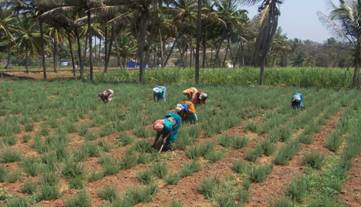 |
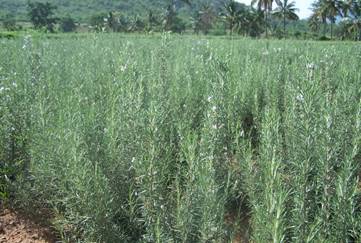 |
| Intercultural operation |
Crop at flowering stage |
|
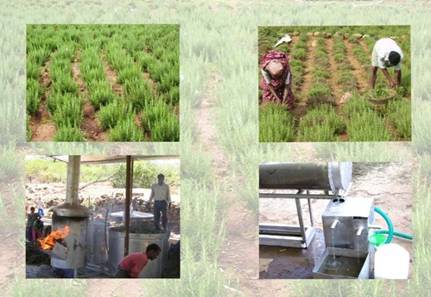 |
 |
 |
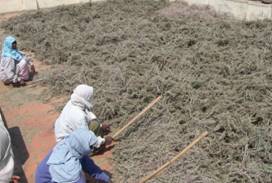 |
| Harvesting and extraction of oil |
Drying |
Thrashing |
Yield
On an average, about 12-15t/ha/annum of herbage and an oil yield of about 85 to 100 kg/ha/annum can be obtained. |
|









